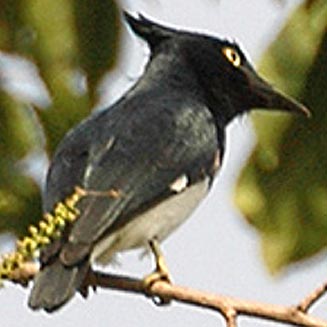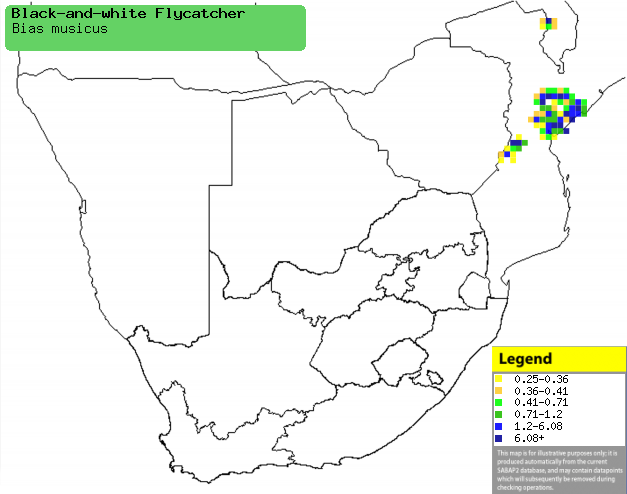|
Bias musicus (Black-and-white
flycatcher, Vanga flycatcher)
WitpensvlieŽvanger [Afrikaans]; Zwartwitte
klauwiervliegenvanger [Dutch]; Bias musicien [French]; Vangaschnšpper [German];
Papa-moscas-branco-e-preto [Portuguese]
Life
> Eukaryotes >
Opisthokonta
> Metazoa (animals) >
Bilateria >
Deuterostomia > Chordata >
Craniata > Vertebrata (vertebrates) > Gnathostomata (jawed
vertebrates) > Teleostomi (teleost fish) > Osteichthyes (bony fish) > Class:
Sarcopterygii (lobe-finned
fish) > Stegocephalia (terrestrial
vertebrates) > Tetrapoda
(four-legged vertebrates) > Reptiliomorpha > Amniota >
Reptilia (reptiles) >
Romeriida > Diapsida > Archosauromorpha > Archosauria >
Dinosauria
(dinosaurs) > Saurischia > Theropoda (bipedal predatory dinosaurs) >
Coelurosauria > Maniraptora > Aves
(birds) >
Order: Passeriformes
> Family: Malaconotidae
 |
|
|
Black-and-white flycatcher male. [photo Tom Tarrant ©] |
|
Distribution and habitat
Patchily distributed across sub-Saharan Africa, occurring
in the DRC, West African coast, Tanzania and Mozambique. In southern Africa it
is uncommon to rare, with populations scattered across central Mozambique,
especially in clearings in Lowland forest and edges of Miombo woodland.
|
 |
|
Distribution of Black-and-white flycatcher in southern Africa,
based on statistical smoothing of the records from first SA Bird Atlas
Project (©
Animal Demography unit, University of
Cape Town; smoothing by Birgit Erni and Francesca Little). Colours range
from dark blue (most common) through to yellow (least common). |
Food
It mainly eats insects, catching most of its prey while on
the wing, either hawking or gleaning them from leaves and branches. The
following food items have been recorded in its diet:
Breeding
- The female does most of the construction work on the nest, which consists
of a neat, shallow cup built of thin stems, leaf stalks, rootlets, skeletons
and bark, cemented with spider web and decorated with lichen. It is usually
placed on a horizontal branch between upright twigs.
- Egg-laying season is from September-December.
- It lays 2-3 eggs, which are incubated by both sexes for 18-19 days,
alternating in shifts of 10-70 minutes.
- The chicks are cared for by both parents, leaving the nest after about
18-23 days. They are still fed by the parents for 2 weeks - 3 months, only
becoming fully independent a month or two before the next breeding season
(sometimes earlier).
Threats
Not threatened.
References
-
Hockey PAR, Dean WRJ and Ryan PG 2005. Roberts
- Birds of southern Africa, VIIth ed. The Trustees of the John Voelcker
Bird Book Fund, Cape Town.
|
